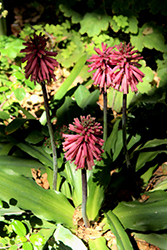Fri & Sat 8am - 8pm
Sun 8am - 7pm
Anytown, USA 12345
fax: 261.787.0463
e-mail: info@successgc.com


Plant Finder

Plant Height: 8 inches
Flower Height: 24 inches
Spacing: 14 inches
Sunlight:
![]()
![]()
Other Names: Cape Lily, Sand Onion, Winter Red Hot Poker
Description:
Dramatic rose-pink bottlebrush type flowers rise in winter from a rosette of broad, strap-like glossy foliage that dies back in summer; a brilliant indoor accent plant for a bright area; reduce moisture after blooming; divide when dormant
Features & Attributes
Forest Lily features bold spikes of rose tubular flowers with pink overtones and green tips at the ends of the stems from early to late winter. The flowers are excellent for cutting. Its large glossy sword-like leaves remain dark green in color throughout the year. The dark red stems are very effective and add to the plant's interest.
This is an open herbaceous houseplant with tall flower stalks held atop a low mound of foliage. Its relatively coarse texture stands it apart from other indoor plants with finer foliage. This plant should never be pruned unless absolutely necessary, as it tends not to take pruning well.
Planting & Growing
When grown indoors, Forest Lily can be expected to grow to be about 8 inches tall at maturity extending to 24 inches tall with the flowers, with a spread of 18 inches. It grows at a medium rate, and under ideal conditions can be expected to live for approximately 10 years. This houseplant performs well in both bright or indirect sunlight and strong artificial light, and can therefore be situated in almost any well-lit room or location. It does best in average to evenly moist soil, but will not tolerate standing water. The surface of the soil shouldn't be allowed to dry out completely, and so you should expect to water this plant once and possibly even twice each week. Be aware that your particular watering schedule may vary depending on its location in the room, the pot size, plant size and other conditions; if in doubt, ask one of our experts in the store for advice. To help it achive its best flowering performance, you may periodically apply a flower-boosting fertilizer throughout the active blooming season. It is not particular as to soil pH, but grows best in sandy soil. Contact the store for specific recommendations on pre-mixed potting soil for this plant.
There are many factors that will affect the ultimate height, spread and overall performance of a plant when grown indoors; among them, the size of the pot it's growing in, the amount of light it receives, watering frequency, the pruning regimen and repotting schedule. Use the information described here as a guideline only; individual performance can and will vary. Please contact the store to speak with one of our experts if you are interested in further details concerning recommendations on pot size, watering, pruning, repotting, etc.
-- THIS IS A HOUSEPLANT AND IS NOT MEANT TO SURVIVE THE WINTER OUTDOORS IN OUR CLIMATE --
